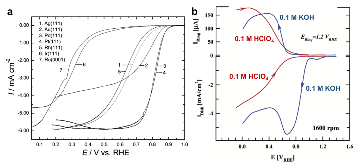Oxygen Reduction on Gold Nanocrystal Surfaces in Alkaline Electrolyte: Evidence for Surface Proton Transfer Effects
Abstract
Four-electron oxygen reduction reaction (4e-ORR) pathway, as a key high-performance reaction pathway in energy conversion, has been sought after in numerous investigations on metal surfaces over the last decades. Although the surfaces of the most noble metals, including platinum and palladium, demonstrate the fullpotential- range 4e-ORR, this is not the case, for gold (Au) surfaces. The 4e-ORR is only operative on Au surfaces with {100} subfacets, e.g. Au(100), in alkaline solution, however restricted to a certain potential region at low overpotentials, while reverting to a 2e-ORR at high overpotentials. This ORR on Au(100) has been a long-standing puzzle of electrocatalysis. Hereby we review the ORR studies on Au, along with the studies of water effects on Au catalysts, and present our electrochemical results with monofacet Au nanocrystals. Finally, combining with theoretical calculations we demonstrate that surface proton transfer from co-adsorbed water plays the key role in determining the ORR mechanism on Au surfaces in base.
- Authors:
-
- Brookhaven National Lab. (BNL), Upton, NY (United States)
- Brookhaven National Lab. (BNL), Upton, NY (United States); Columbia Univ., New York, NY (United States)
- Publication Date:
- Research Org.:
- Brookhaven National Lab. (BNL), Upton, NY (United States)
- Sponsoring Org.:
- USDOE Office of Science (SC), Basic Energy Sciences (BES)
- OSTI Identifier:
- 1430856
- Report Number(s):
- BNL-203376-2018-JAAM
Journal ID: ISSN 1938-6737
- Grant/Contract Number:
- SC0012704
- Resource Type:
- Journal Article: Accepted Manuscript
- Journal Name:
- ECS Transactions (Online)
- Additional Journal Information:
- Journal Volume: 85; Journal Issue: 12; Journal ID: ISSN 1938-6737
- Publisher:
- Electrochemical Society
- Country of Publication:
- United States
- Language:
- English
- Subject:
- 37 INORGANIC, ORGANIC, PHYSICAL AND ANALYTICAL CHEMISTRY
Citation Formats
Zhang, Yu, Lu, Fang, Liu, Shizhong, Lu, Deyu, Su, Dong, Liu, Mingzhao, Zhang, Yugang, Liu, Ping, Wang, Jia X., Adzic, Radoslav R., and Gang, Oleg. Oxygen Reduction on Gold Nanocrystal Surfaces in Alkaline Electrolyte: Evidence for Surface Proton Transfer Effects. United States: N. p., 2018.
Web. doi:10.1149/08512.0093ecst.
Zhang, Yu, Lu, Fang, Liu, Shizhong, Lu, Deyu, Su, Dong, Liu, Mingzhao, Zhang, Yugang, Liu, Ping, Wang, Jia X., Adzic, Radoslav R., & Gang, Oleg. Oxygen Reduction on Gold Nanocrystal Surfaces in Alkaline Electrolyte: Evidence for Surface Proton Transfer Effects. United States. https://doi.org/10.1149/08512.0093ecst
Zhang, Yu, Lu, Fang, Liu, Shizhong, Lu, Deyu, Su, Dong, Liu, Mingzhao, Zhang, Yugang, Liu, Ping, Wang, Jia X., Adzic, Radoslav R., and Gang, Oleg. 2018.
"Oxygen Reduction on Gold Nanocrystal Surfaces in Alkaline Electrolyte: Evidence for Surface Proton Transfer Effects". United States. https://doi.org/10.1149/08512.0093ecst. https://www.osti.gov/servlets/purl/1430856.
@article{osti_1430856,
title = {Oxygen Reduction on Gold Nanocrystal Surfaces in Alkaline Electrolyte: Evidence for Surface Proton Transfer Effects},
author = {Zhang, Yu and Lu, Fang and Liu, Shizhong and Lu, Deyu and Su, Dong and Liu, Mingzhao and Zhang, Yugang and Liu, Ping and Wang, Jia X. and Adzic, Radoslav R. and Gang, Oleg},
abstractNote = {Four-electron oxygen reduction reaction (4e-ORR) pathway, as a key high-performance reaction pathway in energy conversion, has been sought after in numerous investigations on metal surfaces over the last decades. Although the surfaces of the most noble metals, including platinum and palladium, demonstrate the fullpotential- range 4e-ORR, this is not the case, for gold (Au) surfaces. The 4e-ORR is only operative on Au surfaces with {100} subfacets, e.g. Au(100), in alkaline solution, however restricted to a certain potential region at low overpotentials, while reverting to a 2e-ORR at high overpotentials. This ORR on Au(100) has been a long-standing puzzle of electrocatalysis. Hereby we review the ORR studies on Au, along with the studies of water effects on Au catalysts, and present our electrochemical results with monofacet Au nanocrystals. Finally, combining with theoretical calculations we demonstrate that surface proton transfer from co-adsorbed water plays the key role in determining the ORR mechanism on Au surfaces in base.},
doi = {10.1149/08512.0093ecst},
url = {https://www.osti.gov/biblio/1430856},
journal = {ECS Transactions (Online)},
issn = {1938-6737},
number = 12,
volume = 85,
place = {United States},
year = {Sun Apr 01 00:00:00 EDT 2018},
month = {Sun Apr 01 00:00:00 EDT 2018}
}
Figures / Tables:
 Figure 1: (a) ORR polarization curves measured using a rotating-disk-electrode (RDE) on different metal single crystals in O2-saturated 0.1 M NaOH at 1600 rpm and 5 mV s−1. Reprinted with permission from reference (2). Copyright (2007) American Chemical Society. (b) Oxygen reduction (bottom part) and peroxide oxidation (upper part) currentsmore »
Figure 1: (a) ORR polarization curves measured using a rotating-disk-electrode (RDE) on different metal single crystals in O2-saturated 0.1 M NaOH at 1600 rpm and 5 mV s−1. Reprinted with permission from reference (2). Copyright (2007) American Chemical Society. (b) Oxygen reduction (bottom part) and peroxide oxidation (upper part) currentsmore »
Figures / Tables found in this record: